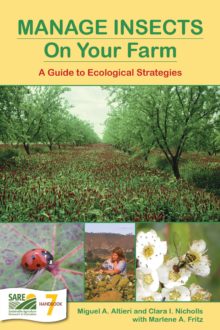Designing a Habitat Management Strategy
The most successful examples of ecologically based pest management systems are those that have been derived and fine-tuned by farmers to fit their particular circumstances. To design an effective plan for successful habitat management, first gather as much information as you can. Make a list of the most economically damaging pests on your farm. For each pest, try to find out:
- What are its food and habitat requirements?
- What factors influence its abundance?
- When does it enter the field and from where?
What attracts it to the crop?
- How does it develop in the crop and when does it become economically damaging?
- What are its most important predators, parasites and pathogens?
- What are the primary needs of those beneficial organisms?
- Where do these beneficials overwinter, when do they appear in the field, where do they come from, what attracts them to the crop, how do they develop in the crop and what keeps them in the field?
- When do the beneficials’ critical resources — nectar, pollen, alternative hosts and prey — appear and how long are they available? Are alternate food sources accessible nearby and at the right times? Which native annuals and perennials can compensate for critical gaps in timing, especially when prey are scarce?
- See Resources and/or contact your county extension agent to help answer these questions.
CAUTION: Converting to organic production is no guarantee that your fields will be pest-free, even if you surround them with natural vegetation. Pest levels are site-specific: they depend on which plants are present, which insects are associated with them and how you manage both.
The examples below illustrate specific management options to address specific pest problems:
- In England, a group of scientists learned that important beneficial predators of aphids in wheat over-wintered in grassy hedgerows along the edges of fields. However, these predators migrated into the crop too late in the spring to manage aphids located deep in the field. After the researchers planted a 3-foot strip of bunch grasses in the center of the field, populations of over-wintering predators soared and aphid damage was minimized.
- Many predators and parasites require alternative hosts during their life cycles. Lydella thompsoni, a tachinid fly that parasitizes European corn borer, emerges before corn borer larvae are available in the spring and completes its first generation on common stalk borer instead. Clean farming practices that eliminate stalk borers are thought to contribute to this tachinid fly’s decline.
- Alternative prey also may be important in building up predator numbers before the predator’s target prey — the crop pest — appears. Lady beetles and minute pirate bugs can eventually consume many European corn borer eggs, but they can’t do it if alternative prey aren’t available to them before the corn borers lay their eggs.
- High daytime soil temperatures may limit the activity of ground-dwelling predators, including spiders and ground beetles. Cover crops or intercrops may help reduce soil temperatures and extend the time those predators are active. Crop residues, mulches and grassy field borders can offer the same benefits. Similarly, many parasites need moderate temperatures and higher relative humidity and must escape fields in the heat of day to find shelter in shady areas. For example, a parasitic wasp that attacks European corn borers is most active at field edges near woody areas, which provide shade, cooler temperatures and nectar-bearing or honeydew-coated flowering plants.
